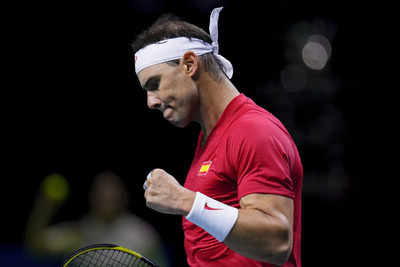Rafael Nadal: Legacy, setbacks… key moments that defined tennis star’s career

Rafael Nadal reacts during his final professional match in Malaga. (AP Photo)
Rafael Nadal, widely regarded as one of the greatest athletes of all time, has officially announced his retirement from professional tennis, following the 2024 Davis Cup Finals in Málaga, Spain. His departure marks the end of an era in tennis; a career defined by unparalleled achievements, a relentless fighting spirit, and a style of play that captured hearts worldwide.
Achievements and Legacy
From his professional debut in 2001 to his farewell in 2024, Nadal built a career that stands among the finest in sports history. His 22 Grand Slam titles; second only to Novak Djokovic are headlined by a record-shattering 14 French Open wins, which earned him the title “King of Clay.” Beyond the Slams, Nadal secured 92 career titles over his 23-year professional career, including 36 Masters 1000 tournaments, Olympic gold medals in singles (2008) and doubles (2016). A record-tying five Davis Cup victories with Spain.
Nadal’s consistency was legendary, as he spent 209 weeks as World No. 1 and ended five seasons at the top spot. His achievements extend to all playing surfaces, as he is one of only three men (alongside Roger Federer and Djokovic) to complete the Career Grand Slam twice. Nadal’s legacy goes beyond trophies. His humility, respect for opponents, and leadership in initiatives like the Rafael Nadal Academy have made him a global role model. His influence transcends tennis, inspiring countless young athletes.
READ ALSO
Ademola Lookman or Achraf Hakimi? Spotlighting 2024 CAF men’s final shortlist
Boniface, Okoye underperformed, midfield still a problem… analysing Nigeria’s defeat to Rwanda
From mockery to Man U hero: Can André Onana Win EPL Golden Glove?
Ademola Lookman: Stay at Atalanta or Move to a Bigger Club?
Setbacks and Resilience
As typical of all legend story, setbacks and challenges always occur and Nadal’s career had a fair share of such challenging incidents. However, he was as much about his triumphs as his resilience. Plagued by chronic injuries, he faced numerous setbacks that would have ended most players’ careers. Nadal suffered knee tendinitis, a recurring issue that forced him to miss key tournaments, including 2009 Wimbledon and the 2012 US Open. He also suffered from wrist injuries in 2003 and 2016 which sidelined him while he was at the peak of his career, including the 2003, 2004 and 2016 French Open. More also Nadal was faced with the Müller-Weiss Syndrome, a degenerative foot condition that heavily impacted his later years.
Despite these challenges, Nadal’s ability to adapt and recover was extraordinary. He continually evolved his game to reduce physical strain while maintaining competitiveness. His return to win the 2022 Australian Open after a six-month hiatus proved that he is still a resilient tennis player.
Style of Play
Nadal’s playing style was a blend of physicality, precision, and strategy. Known for his explosive forehand with heavy topspin, Nadal excelled in baseline battles, forcing errors from even the most skilled opponents. His game was defined by; relentless defense and the ability to chase down impossible balls and turn defense into offense was marvelous. Mental toughness, Nadal thrived in high-pressure situations, boasting a remarkable record in five-set matches. Adaptability: While clay was his forte, Nadal developed his serve and net game to excel on hard and grass courts. His match fitness and stamina earned him victories in some of the sport’s greatest rivalries, particularly against Roger Federer and Novak Djokovic.
Rivalries That Defined an Era
The Nadal-Federer-Djokovic trio dominated tennis for nearly two decades, collectively winning 66 Grand Slam titles. Nadal’s contrasting styles with Federer could be expressed as grace vs. grit and the one he had with Djokovic could be seen as precision against power which produced some of tennis’s most iconic matches, such as the 2008 Wimbledon final, often hailed as the greatest tennis match ever played.
The Final Chapter
Nadal’s choice to retire at the Davis Cup Finals is emotionally touching, as it draws the curtain close on his career, which began with a Davis Cup triumph in 2004. Reflecting on his journey, Nadal expressed gratitude for his team and fans, emphasizing that his decision stemmed from the physical toll of competing at the highest level. His post-retirement plans are already taking shape. The Rafael Nadal Academy, based in his hometown of Manacor, Mallorca, Spain continues to produce promising young players. Nadal’s involvement in tennis, regardless in a different capacity, is expected to inspire future generations.
A Lasting Legacy
As Nadal steps away from the ATP tour, his contributions to tennis will resonate for decades. From his records on the court to his philanthropic work off it, Nadal epitomizes excellence, resilience, and sportsmanship. Fans will remember him not only as a champion but as a symbol of what is possible through dedication and passion. Rafael Nadal’s retirement is not just the end of a career; it is the closing of a chapter in sports history. Yet, his story will continue to inspire millions of people across the globe.


